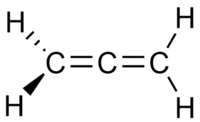
Photo from wikipedia
Strained cyclic organic molecules, such as arynes, cyclic alkynes and cyclic allenes, have intrigued chemists for more than a century with their unusual structures and high chemical reactivity 1 .… Click to show full abstract
Strained cyclic organic molecules, such as arynes, cyclic alkynes and cyclic allenes, have intrigued chemists for more than a century with their unusual structures and high chemical reactivity 1 . The considerable ring strain (30–50 kilocalories per mole) 2 , 3 that characterizes these transient intermediates imparts high reactivity in many reactions, including cycloadditions and nucleophilic trappings, often generating structurally complex products 4 . Although strategies to control absolute stereochemistry in these reactions have been reported using stoichiometric chiral reagents 5 , 6 , catalytic asymmetric variants to generate enantioenriched products have remained difficult to achieve. Here we report the interception of racemic cyclic allene intermediates in a catalytic asymmetric reaction and provide evidence for two distinct mechanisms that control absolute stereochemistry in such transformations: kinetic differentiation of allene enantiomers and desymmetrization of intermediate π-allylnickel complexes. Computational studies implicate a catalytic mechanism involving initial kinetic differentiation of the cyclic allene enantiomers through stereoselective olefin insertion, loss of the resultant stereochemical information, and subsequent introduction of absolute stereochemistry through desymmetrization of an intermediate π-allylnickel complex. These results reveal reactivity that is available to cyclic allenes beyond the traditional cycloadditions and nucleophilic trappings previously reported, thus expanding the types of product accessible from this class of intermediates. Additionally, our computational studies suggest two potential strategies for stereocontrol in reactions of cyclic allenes. Combined, these results lay the foundation for the development of catalytic asymmetric reactions involving these classically avoided strained intermediates. Asymmetric nickel catalysis is used to intercept transient cyclic allene intermediates to achieve stereocontrol.
Journal Title: Nature
Year Published: 2020
Link to full text (if available)
Share on Social Media: Sign Up to like & get
recommendations!